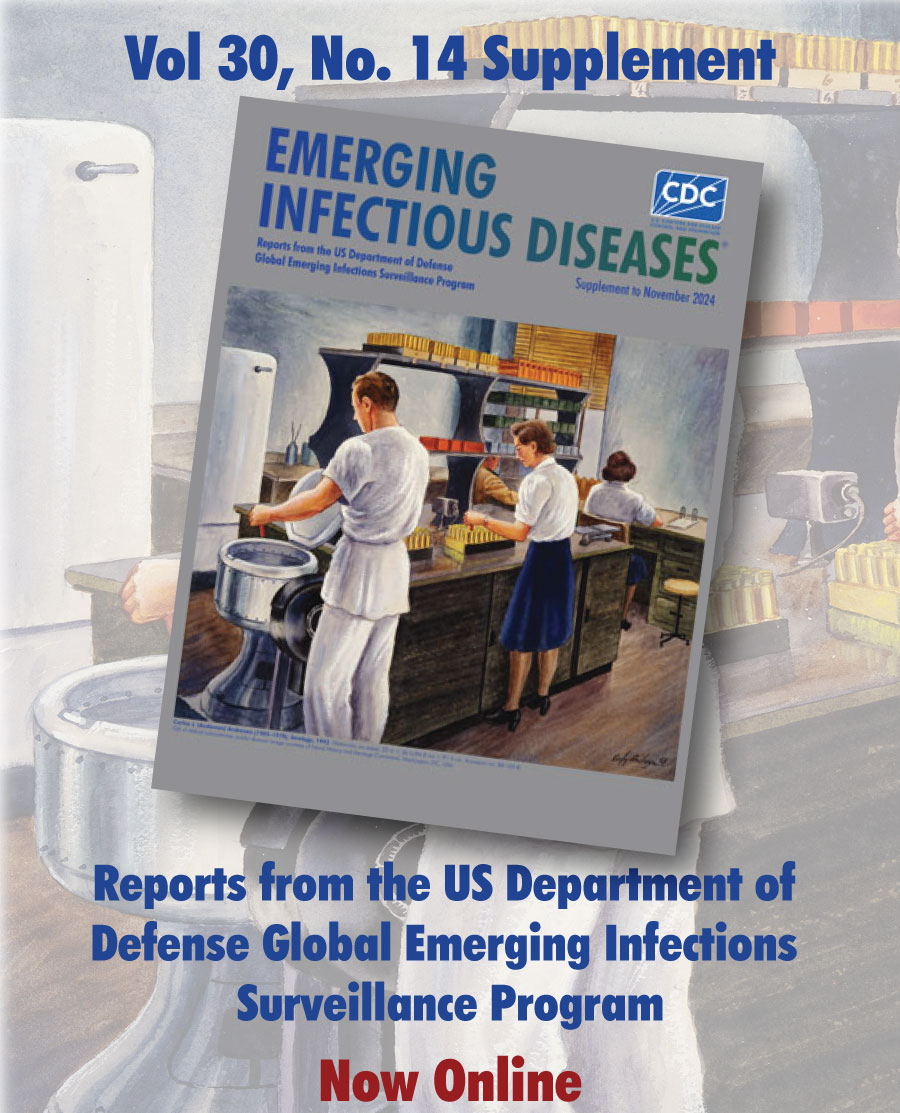Early Release
Disclaimer: Early release articles are not considered as final versions. Any changes will be reflected in the online version in the month the article is officially released.
Volume 31, Number 2—February 2025
Synopses
- National Surveillance of Human Ehrlichiosis Caused by Ehrlichia ewingii, United States, 2013–2021
- Two Human Cases of Fatal Meningoencephalitis Associated with Potosi and Lone Star Viruses, United States, 2020–2023
Research
-
Short-Lived Neutralizing Antibody Responses to Monkeypox Virus in Smallpox Vaccine–Naive Persons after JYNNEOS Vaccination
JYNNEOS, a third-generation smallpox vaccine, is integral to monkeypox virus (MPXV) control efforts, but the durability of this modified vaccinia Ankara–Bavarian Nordic (MVA-BN) vaccine’s effectiveness is undefined. We optimized and used a plaque reduction neutralization test (PRNT) with authentic clade IIa MPXV and vaccinia virus to assess antibody responses over 12 months in 8 donors vaccinated with 2 doses of JYNNEOS. One donor previously received the ACAM2000 vaccine; 7 donors were smallpox vaccine–naive. IgG responses of the donors to vaccinia virus (L1, B5, and A33) or MPXV (E8, H3, A35) antigens and PRNT titers to both viruses peaked at 8 weeks postvaccination and waned rapidly thereafter in naive donors. MPXV PRNT titers were especially low; no naive donors demonstrated 90% plaque reduction. These data indicate a need for improved correlates of MPXV immunity to enable MVA-BN durability studies, given that recent clinical data support MVA-BN vaccine efficacy against MPXV despite low antibody responses.
- Cyclospora Genotypic Variations and Associated Epidemiologic Characteristics, United States, 2018–2021
- Epidemiologic and Genomic Surveillance of Vibrio cholerae and Effectiveness of Single-Dose Oral Cholera Vaccine, Democratic Republic of the Congo
-
Respiratory Shedding of Infectious SARS-CoV-2 Omicron XBB.1.41.1 Lineage among Captive White-Tailed Deer, Texas, USA
White-tailed deer (Odocoileus virginianus) have high value for research, conservation, agriculture, and recreation and might be key SARS-CoV-2 reservoirs. In November 2023, we sampled 15 female deer in a captive facility in Texas, USA. All deer had neutralizing antibodies to SARS-CoV-2; respiratory swab samples from 11 deer were SARS-CoV-2–positive by quantitative reverse transcription PCR, and 1 deer also had a positive rectal swab sample. Six of the 11 respiratory swab samples yielded infectious virus; replication kinetics of most samples displayed lower growth 24–48 hours postinfection in vitro than Omicron lineages isolated from humans in Texas in the same period. Virus growth was similar between groups by 72 hours, suggesting no strong attenuation of deer-derived virus. All deer viruses clustered in XBB Omicron clade and demonstrated more mutations than expected compared with contemporaneous viruses in humans, suggesting that crossing the species barrier was accompanied by a high substitution rate.
-
Prions in Muscles of Cervids with Chronic Wasting Disease, Norway
Chronic wasting disease (CWD) is an emerging prion disease in Nordic countries and has been detected in reindeer, moose, and red deer since 2016. CWD sporadically detected in moose and red deer in 3 Nordic countries demonstrated pathologic and strain characteristics different from CWD in reindeer, including an unexpected lack of prions outside the central nervous system as measured by standard diagnostic tests. Using protein misfolding cyclic amplification, we detected prions in the lymphoreticular system of moose and red deer with CWD in Norway and, remarkably, in muscles of both of those species and in CWD-infected reindeer. One moose lymph node and 1 moose muscle sample showed infectivity when experimentally transmitted to bank voles. Our findings highlight the systemic nature of CWD strains in Europe and raise questions regarding the risk of human exposure through edible tissues.
- Streptococcus pyogenes emm Type 3.93 Emergence, the Netherlands and England
- Limited Molecular Testing Contributes to Low Ehrlichiosis Diagnosis in High Incidence Area
-
Sudan Virus Persistence in Immune-Privileged Organs of Nonhuman Primates
After the 2022–2023 Sudan virus (SUDV) disease outbreak in Uganda, we studied SUDV persistence in nonhuman primates that had survived acute infection without therapeutic intervention. We identified SUDV persistence in the vitreous chamber and immediately adjacent tissue in the eyes as well as in the seminiferous tubules in the testes but not in common target organs typically infected during the acute phase of disease. Specifically, SUDV persists primarily in macrophages in the eyes and Sertoli cells in the testes. Ocular and testicular SUDV persistence in nonhuman primates is accompanied by tissue damage, including inflammatory cell invasion. Our study suggests that long-term follow-up efforts are needed to reduce possible recrudescent disease and reignition of outbreaks caused by virus persistence in human survivors of SUDV infection.
Dispatches
- Reemergence of Echinococcus granulosus Infections after 2004 Termination of Control Program in Magallanes Region, Chile
- Infection by Tick-Borne Bacterium Candidatus Midichloria Associated with First Trimester Pregnancy Loss, Tennessee, USA
-
Seoul Virus Infection and Subsequent Guillain-Barré Syndrome in Traveler Returning to France from Kenya, 2022
Seoul virus (SEOV) is a worldwide ratborne orthohantavirus. We describe an SEOV infection in an adult returning to France from Kenya, followed by Guillain-Barré syndrome. We confirmed SEOV infection by PCR and sequencing. Although transmission might have occurred in Kenya, the epidemiologic information available is not sufficient to confirm that possibility.
- East African Origin of SAT2 Topotype XIV Foot-and-Mouth Disease Virus Outbreaks, Western Asia, 2023
- Borrelia spielmanii–Associated Neuroborreliosis in Patient Receiving Rituximab, Belgium
-
Acute Q Fever Patients Requiring Intensive Care Unit Support in Tropical Australia, 2015–2023
Acute Q fever is classically described as a mild illness. We report 9 patients with acute Q fever in Queensland, Australia, who required intensive care unit support to survive. Clinicians should consider an acute Q fever diagnosis and its empirical treatment in critically ill persons in the appropriate clinical context.
-
Two Human Infections with Diverse Europe-1 Crimean-Congo Hemorrhagic Fever Virus Strains, North Macedonia, 2024
Until 2023, North Macedonia had not reported a Crimean-Congo hemorrhagic fever (CCHF) case for >50 years. In 2024, increased clinical vigilance identified and characterized 2 novel CCHF cases. Genetic analysis and the identification of possible reassortment indicate North Macedonia as an interaction zone between CCHF virus isolates from Turkey and Kosovo.
-
Diphtheria Toxin–Producing Corynebacterium ramonii in Inner-City Population, Vancouver, British Columbia, Canada, 2019–2023
We conducted patient chart reviews and whole-genome sequencing of wound specimens containing presumptive Corynebacterium ulcerans from Vancouver, British Columbia, Canada, during July 2019–July 2023. Sequencing confirmed 8/14 isolates were C. ramonii and identified 2 distinct clusters. Molecular methods should be used to clinically differentiate potential toxin-producing Corynebacterium spp.
-
Comparison of Contemporary and Historic Highly Pathogenic Avian Influenza A(H5N1) Virus Replication in Human Lung Organoids
We compared virus replication and host responses in human alveolar epithelium infected with highly pathogenic avian influenza (HPAI) A(H5N1) viruses. A/Vietnam/1203/2004 replicated most efficiently, followed by A/Texas/37/2024, then A/bovine/Ohio/B24OSU-342/2024. Induction of interferon-stimulated genes was lower with A/Texas/37/2024 and A/bovine/Ohio/B24OSU-342/2024, which may indicate a reduced disease severity of those viruses.
- Detection of Chronic Wasting Disease Prions in Raw, Processed, and Cooked Elk Meat, Texas, USA
- Dengue and Other Arbovirus Infections among Schoolchildren, Haiti, 2021
- Detection of Bjerkandera adusta as Causative Agent of Invasive Chronic Rhinosinusitis
-
Bacteremia and Community-Acquired Pneumonia Caused by Pantoea stewartii Subspecies indologenes, Australia
We report infection with the phytopathogen Pantoea stewartii subspecies indologenes in a macadamia farmer from southeast Queensland, Australia. The patient had bloodstream infection and pneumonia develop after an unidentified inoculation event. Investigation determined that the most likely mode of transmission was inhalation from an environmental source on the farm.
-
Mycoplasma phocimorsus in Woman with Tendinous Panaritium after Cat Scratch, Denmark
A panaritium developed in a woman in Demark after her cat scratched her. Analysis of tissue by 16S rRNA gene sequencing revealed Mycoplasma phocimorsus, known to cause seal finger. The source of the bacterium likely transmitted by the cat is unknown, but awareness of potential zoonotic transmission from cats should be raised.
Research Letters
- Venezuelan Equine Encephalitis Virus Infection in Nonhuman Primate, Guatemala, 2023
- Sin Nombre Virus as an Unlikely Reverse Zoonotic Threat
-
Acute Encephalopathy Associated with Human Adenovirus Type 14 Infection in 7-Year-Old Girl, Japan
Only 2 cases of human adenovirus type 14 (HAdV-14) have been reported in Japan since 1980. We report a 7-year-old girl with acute encephalopathy associated with HAdV-14 infection genetically similar to strains from the United States. The patient had not had contact with international travelers. HAdV-14 surveillance should be strengthened in Japan.
-
Zika Virus Infection in Pregnant Traveler Returning to Denmark from Phuket, Thailand, 2024
We report a case of Zika virus (ZIKV) infection in a pregnant woman from Denmark who traveled to Thailand during her first trimester. Late in the second trimester, severe microcephaly was diagnosed in the fetus, and ZIKV infection was confirmed. Travelers and clinicians should be aware of ongoing ZIKV risk in Thailand.
- Burkholderia pseudomallei Sequence Type 46 Transmission from Asia to Australia
- Ixodes scapularis Tick Parasitizing Dog in Dawson County, Montana, USA, 2023
- Henipavirus in the Northern Short-Tailed Shrew, Alabama, USA
- Human Infection with Avian Influenza A(H9N2) Virus, Vietnam, April 2024
Books and Media
- Ending Epidemics: A History of Escape from Contagion
- 2000 Years of Pandemics: Past, Present, and Future, 1st Edition
Online Report
- Arbovirus Epidemics as Global Health Imperative, Africa, 2023
Volume 31, Number 3—March 2025
Research
- Mycobacterium nebraskense Isolated from Patients in Connecticut and Oregon, USA
- Genomic Characterization of Circulating Dengue Virus, Ethiopia, 2022–2023
- High Prevalence of AtpE Mutations in Bedaquiline-Resistant Mycobacterium tuberculosis Isolates, Russia
- Effect of Prior Influenza A(H1N1)pdm09 Virus Infection on Pathogenesis of Human Influenza A(H5N1) Clade 2.3.4.4b Virus Isolate in Ferret Model
Dispatch
- Outbreak of Serotype 1 Invasive Pneumococcal Disease, Kibera Urban Informal Settlement, Nairobi, Kenya, 2023
Research Letters
- Neurosarcocystosis in Patient with HIV-Induced Immunodeficiency
- Fluoroquinolone Resistance in Drug-Resistant Tuberculosis, Kharkiv, Ukraine, 2019–2023
- Community-Acquired Pneumonia Caused by Avian Chlamydia abortus, the Netherlands
- Evaluation of High-Dose Isoniazid Use in Multidrug-Resistant Tuberculosis Treatment
- Lack of Competence of US Mosquito Species in Circulating Oropouche Virus
The requested issue is not available.




